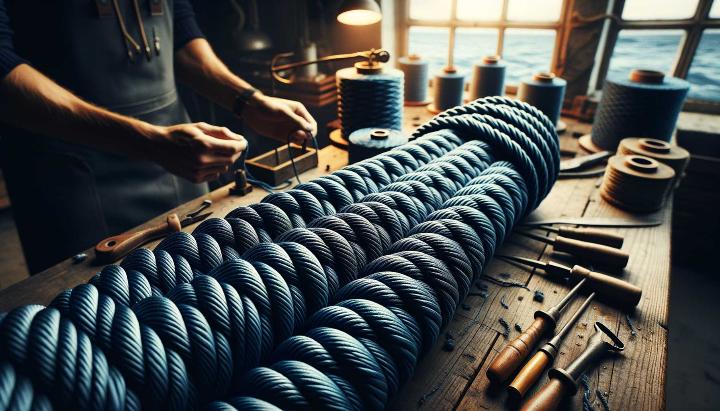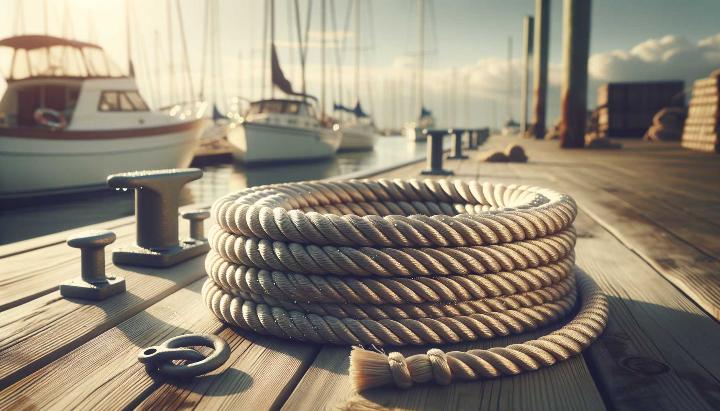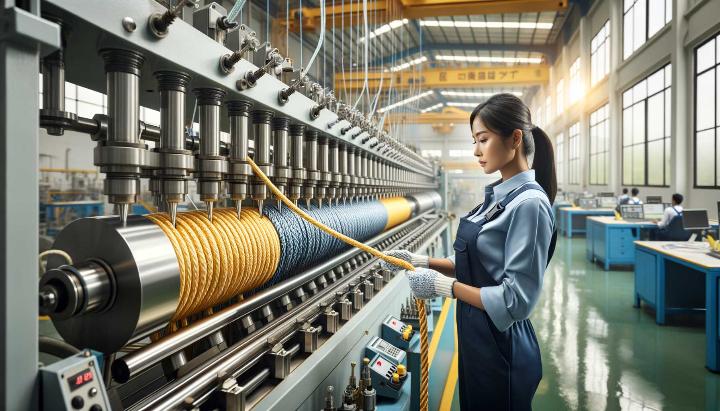Have you ever found yourself dangling precariously from a cliff face, your life quite literally hanging by a thread? Or perhaps you've watched in awe as a massive cargo ship effortlessly docks, tethered by seemingly delicate lines? Welcome to the fascinating world of ropes, where the difference between a safe adventure and a potential disaster often lies in the subtle nuances of strand configuration.
In this comprehensive guide, we'll unravel the mysteries of triple strand rope, triple braided rope, and 3 strand pp rope. These aren't just pieces of cordage; they're marvels of engineering that have revolutionised industries from marine operations to extreme sports. But why should you care about the intricacies of rope construction?
Imagine selecting the wrong rope for a critical application - the consequences could be catastrophic. That's why understanding the unique properties of each rope type is crucial, whether you're a weekend warrior or an industry professional. And who better to guide us through this tangled web than iRopes, a leading rope manufacturer with 15 years of experience crafting high-quality cordage in China?
Join us as we explore how iRopes harnesses cutting-edge synthetic fibres like UHMWPE and Kevlar™ to create over 2,348 different cordage options. We'll discover how their commitment to innovation is redefining the "Made in China" label, proving that world-class quality can indeed come from the Middle Kingdom. So, are you ready to learn the ropes? Let's dive in!
Understanding Triple Strand Rope: Construction and Uses
Have you ever wondered what gives triple strand rope its remarkable strength and versatility? Let's unravel the mystery behind this robust and time-tested rope construction.
Characteristics of 3-Strand Rope
Triple strand rope, as the name suggests, is crafted by intertwining three individual strands of fibre. This simple yet ingenious design creates a rope that's not only strong but also easy to handle. As I run my fingers along a length of 3-strand rope, I can feel the distinctive texture of the larger crowns - those raised spiral patterns that give the rope its characteristic appearance and grip.
Compared to its braided cousins, 3-strand rope has a unique charm. It's like the classic denim of the rope world - rugged, reliable, and always in style. The larger crowns not only provide excellent grip but also make the rope more resistant to abrasion, a crucial feature in demanding marine and industrial environments.
Applications and Advantages of Triple Strand Rope
So, where might you encounter triple strand rope in action? Picture a bustling harbour, with ships securely moored to the docks. That's where 3-strand rope truly shines. Its impressive strength-to-weight ratio makes it ideal for:
- Mooring lines: Keeping vessels safely tied to docks or buoys.
- Towing applications: Whether it's a small boat or a large ship in distress.
- Anchoring: Providing a reliable connection between ship and seabed.
But the versatility of triple strand rope doesn't stop at the water's edge. In industrial settings, it's a go-to choice for heavy lifting and securing loads. Its ability to absorb shock and resist abrasion makes it a trusted companion in construction sites and warehouses alike.
Did you know? The unique construction of 3-strand rope allows it to be easily spliced, even at sea, making it a favourite among sailors for emergency repairs.
One of the most fascinating aspects of 3-strand rope is its ability to be spliced. This technique, which involves interweaving the rope's strands to create a permanent join or loop, is a testament to the rope's user-friendly design. I remember watching an old sailor demonstrate this skill on a weathered dock - his weathered hands moving with practiced ease, creating an eye splice in mere minutes.
As we dive deeper into the world of ropes, you'll discover that understanding the unique properties of each type is crucial for choosing the right rope for your specific needs. Whether you're a seasoned mariner or an industrial professional, the timeless reliability of triple strand rope might just be the solution you've been searching for.
Have you ever used triple strand rope in your work or hobbies? What was your experience? Share your thoughts in the comments below - I'd love to hear your rope tales!
Exploring Triple Braided Rope: Types and Uses
As we delve deeper into the world of ropes, let's unravel the mysteries of triple braided rope. This versatile and robust rope type has gained popularity across various industries, from marine applications to high-performance sports. But what exactly makes it so special?
Understanding 3-Strand Rope Construction
Triple braided rope, also known as 3-strand rope, is crafted by intertwining three individual strands of fibre. This ingenious design creates a rope that's not only strong but also incredibly versatile. As I run my fingers along a length of triple braided rope, I'm struck by its smooth texture and uniform appearance - a stark contrast to the raised crowns of its single-braided cousin.
The construction process involves carefully twisting each strand in one direction, then combining them by twisting in the opposite direction. This technique, known as 'S' and 'Z' twisting, results in a rope that's balanced, stable, and resistant to kinking.
Braiding Techniques for Triple Strand Rope
One of the most fascinating aspects of triple braided rope is its ability to be spliced. This technique, which involves interweaving the rope's strands to create a permanent join or loop, is a testament to the rope's user-friendly design. I remember watching a seasoned sailor demonstrate this skill during a regatta - his weathered hands moving with practiced ease, creating an eye splice in mere minutes.
Pro Tip: When splicing triple braided rope, use a fid tool to help separate the strands and create neat, professional-looking splices. This not only improves the rope's appearance but also maintains its strength at the splice point.
Comparing Triple Braided vs Other Rope Types
So, how does triple braided rope stack up against other types? Let's break it down:
- Strength and durability: Triple braided rope offers exceptional strength-to-weight ratio, making it ideal for heavy-duty applications.
- Flexibility: Its construction allows for greater flexibility compared to single-braided ropes, making it easier to handle and store.
- Abrasion resistance: While not as resistant as some specialised ropes, triple braided rope holds up well against wear and tear in most applications.
- Cost-effectiveness: Generally more affordable than complex braided ropes, triple braided rope offers a great balance of performance and value.
When it comes to high-performance applications, triple braided rope truly shines. In racing sports, for instance, its combination of strength, lightweight construction, and ease of handling makes it a favourite among competitive sailors and climbers alike. For more information on using the optimal braided rope for marine applications, you can find out more here.
Have you ever used triple braided rope in your work or hobbies? What was your experience? I'd love to hear your thoughts in the comments below - let's keep this conversation going!

As we continue our journey through the world of ropes, remember that understanding the unique properties of each type is crucial for choosing the right rope for your specific needs. Whether you're a weekend warrior or a professional in need of high-performance cordage, the versatility and reliability of triple braided rope might just be the solution you've been searching for.
Spotlight on 3 Strand PP Rope: Versatility and Strength
As we dive deeper into our exploration of rope types, let's shine a light on a true workhorse of the marine and industrial worlds: the 3 strand polypropylene rope, or 3 strand PP rope as it's commonly known. This remarkable rope has been a game-changer in many industries, and I'm excited to share with you why it's become such a popular choice.
Properties and Applications of 3 Strand Polypropylene Rope
Picture yourself standing on a sun-drenched dock, the smell of salt in the air, as you coil a length of bright yellow rope in your hands. That's likely a 3 strand PP rope you're holding, and its properties are truly impressive:
- Lightweight yet strong: This rope feels surprisingly light in your hands, but don't be fooled - it can handle hefty loads with ease.
- Floats on water: Toss it into the sea, and it'll bob right back up - a crucial feature for marine rescue operations.
- Chemical and UV resistant: Whether it's exposed to harsh sunlight or industrial chemicals, this rope stands its ground.
- Easy to splice and handle: Even with work-weathered hands, you'll find this rope a breeze to manipulate.
These unique properties make 3 strand PP rope a versatile player across various industries. In my years working with different ropes, I've seen it used in countless applications: for a deeper understanding of polypropylene rope properties, click here.

- Marine uses: From mooring lines to water ski tow ropes, it's a staple on boats of all sizes.
- Industrial applications: I've seen it used for bundling, towing, and even as temporary barriers in construction sites.
- Agriculture: Farmers swear by it for hay baling and securing loads on trailers.
- DIY projects: Its versatility makes it a favourite for home improvement and craft projects.
Compared to natural fibre ropes, 3 strand PP rope offers significant advantages. It doesn't rot or mildew, it's more resistant to abrasion, and it maintains its strength even when wet. Plus, it's more economical, making it an attractive option for budget-conscious buyers.
Maintaining and Sealing 3 Strand PP Rope
To get the most out of your 3 strand PP rope, proper care is essential. Here are some tips I've picked up over the years:
- Rinse after use: Especially if exposed to saltwater or chemicals, a quick freshwater rinse can extend its life.
- Store properly: Keep it in a cool, dry place away from direct sunlight when not in use.
- Inspect regularly: Check for signs of wear or damage, particularly at high-stress points.
Sealing the ends of your rope is crucial to prevent fraying. Here's a simple method I use:
- Cut the rope end cleanly with a sharp knife or hot knife.
- Hold the cut end over a flame for a few seconds, allowing the fibres to melt slightly.
- Quickly press the melted end against a hard, flat surface to seal it.
Safety first! Always wear gloves when sealing rope ends with heat, and work in a well-ventilated area.
With proper care, your 3 strand PP rope can last for years, providing reliable service across a wide range of applications. Have you used this type of rope before? What was your experience? I'd love to hear your thoughts in the comments below!
iRopes' Expertise in Manufacturing High-Quality Ropes
As we reach the pinnacle of our rope exploration, let's dive into the world of iRopes, a true master in the art of rope manufacturing. With 15 years of experience under their belt, iRopes has become synonymous with quality and innovation in the Chinese rope industry. But what sets them apart in this competitive field?
Advanced Manufacturing Techniques for Superior Rope Performance
At the heart of iRopes' success lies their commitment to using cutting-edge synthetic fibers. As I run my fingers along one of their ropes, I'm struck by its incredible strength and lightness. This isn't your grandfather's hemp rope – it's a marvel of modern engineering.
- UHMWPE (Ultra-High-Molecular-Weight Polyethylene): This tongue-twister of a material offers unparalleled strength-to-weight ratio, perfect for heavy-duty applications.
- Technora™: Known for its heat resistance and dimensional stability, it's a go-to for ropes that need to maintain their shape under stress.
- Kevlar™: You might know it from bulletproof vests, but in ropes, it provides exceptional strength and cut resistance.
- Vectran™: This liquid crystal polymer fiber offers high strength and minimal stretch, ideal for precision applications.
But it's not just about the materials. iRopes employs a meticulous manufacturing process that ensures every rope meets the highest standards. From precision braiding to rigorous quality control, each step is designed to create ropes that perform in the most demanding conditions.

Customized Rope Solutions for Various Industries
One size doesn't fit all in the world of ropes, and iRopes understands this better than anyone. Their ability to create tailored rope solutions has made them a favourite across various industries. Let me share a personal anecdote to illustrate this point.
Last year, I visited a construction site where they were using iRopes' custom-made lifting slings. The site manager couldn't stop raving about how these ropes had revolutionized their operations. "They're half the weight of our old steel cables," he told me, "but they can lift twice as much. And the bright orange colour makes them easy to spot, improving our site safety."
This customization extends to other industries as well:
- Marine: Mooring lines that resist saltwater corrosion and UV damage.
- Sports: Ultralight ropes for competitive climbing that offer unparalleled strength and handling.
- Agriculture: Durable, weather-resistant ropes for hay baling and livestock management.
But what truly sets iRopes apart is their commitment to delivering the best "Made in China" products. They've shattered the stereotype of Chinese manufacturing being synonymous with low quality. Instead, they've positioned themselves as a global leader in high-performance rope solutions. If you're interested in more about why you should consider synthetic ropes over traditional wire ropes, this guide can provide further insights.
Did you know? iRopes offers over 2,348 different cordage options, catering to a wide range of industries and applications. Whether you need a rope for deep-sea fishing or space exploration, chances are, iRopes has got you covered!
As we wrap up our journey through the world of ropes, I'm left in awe of how far we've come from the simple twisted fibers of ancient times. Companies like iRopes are pushing the boundaries of what's possible, creating ropes that are stronger, lighter, and more versatile than ever before.
Have you ever used a high-performance synthetic rope in your work or hobbies? How did it compare to traditional ropes? Share your experiences in the comments below – I'd love to hear your thoughts!
```htmlDiscover the intricacies of triple strand rope, triple braided rope, and 3 strand pp rope with iRopes’ comprehensive guide. As a renowned rope manufacturer with over 15 years of experience in China, iRopes excels in crafting high-quality ropes using advanced synthetic fibres like UHMWPE, Technora™, and Kevlar™. Triple strand ropes offer unmatched strength, making them ideal for marine and industrial use, while the lightweight and flexible triple braided ropes cater to high-performance sports. Meanwhile, the 3 strand pp rope, known for its floatability and chemical resistance, is a versatile choice for marine and safety applications. Our detailed guide helps you make informed choices, ensuring your specific needs are met with quality "Made in China" products from iRopes.
Learn More and Inquire About Custom Solutions
Fill out the form above to connect with our experts, discuss your specific needs, and explore custom rope solutions that align with your requirements. Whether it’s for marine, industrial, or sporting applications, iRopes has the durability and expertise you need to excel.
```